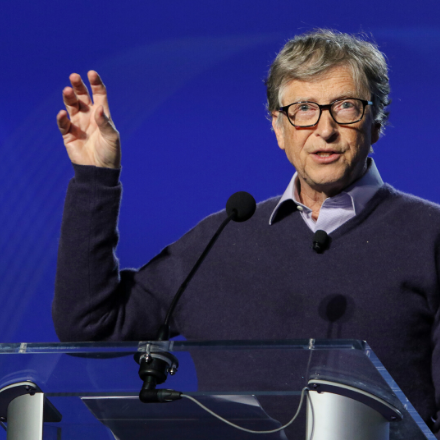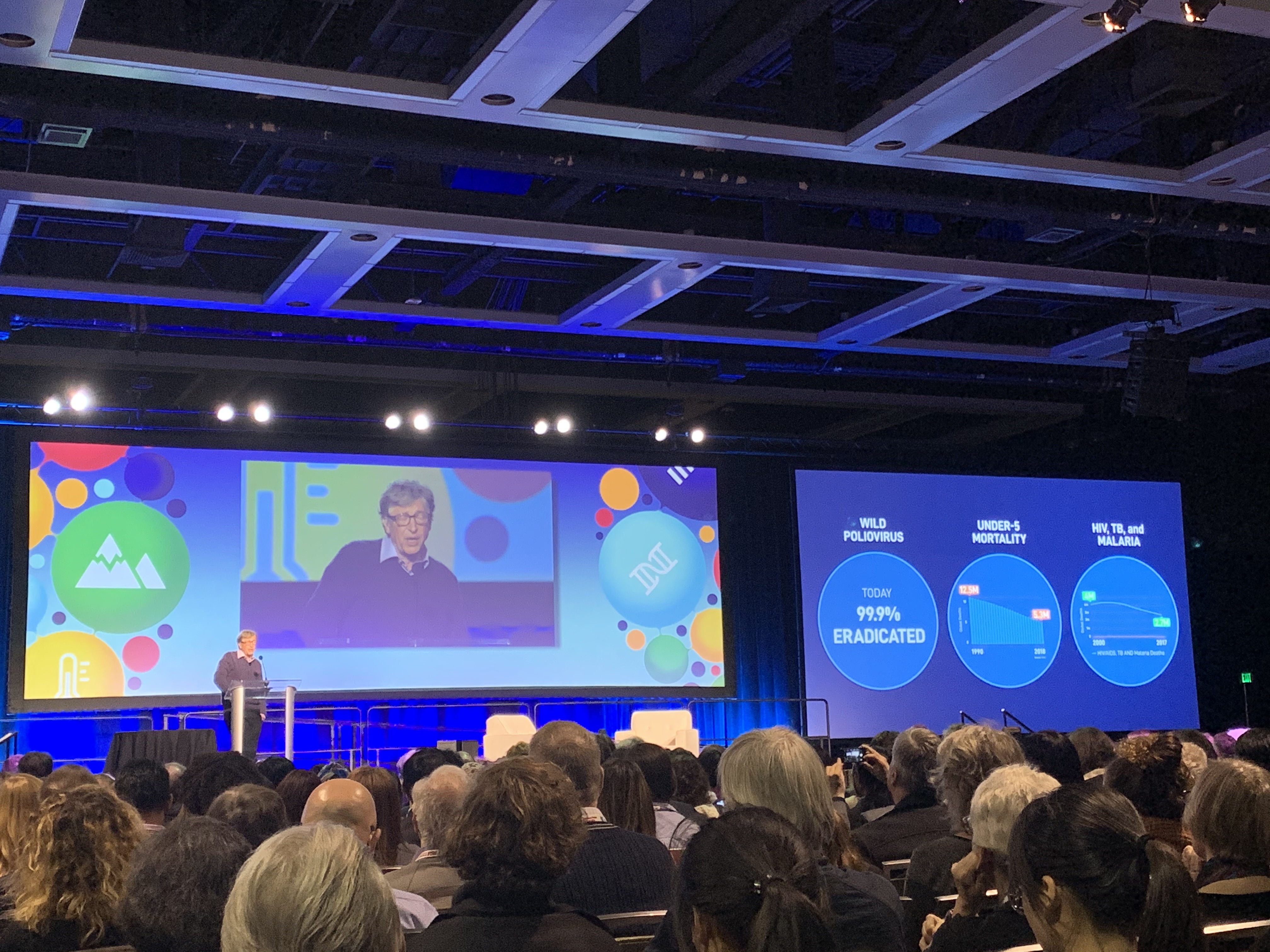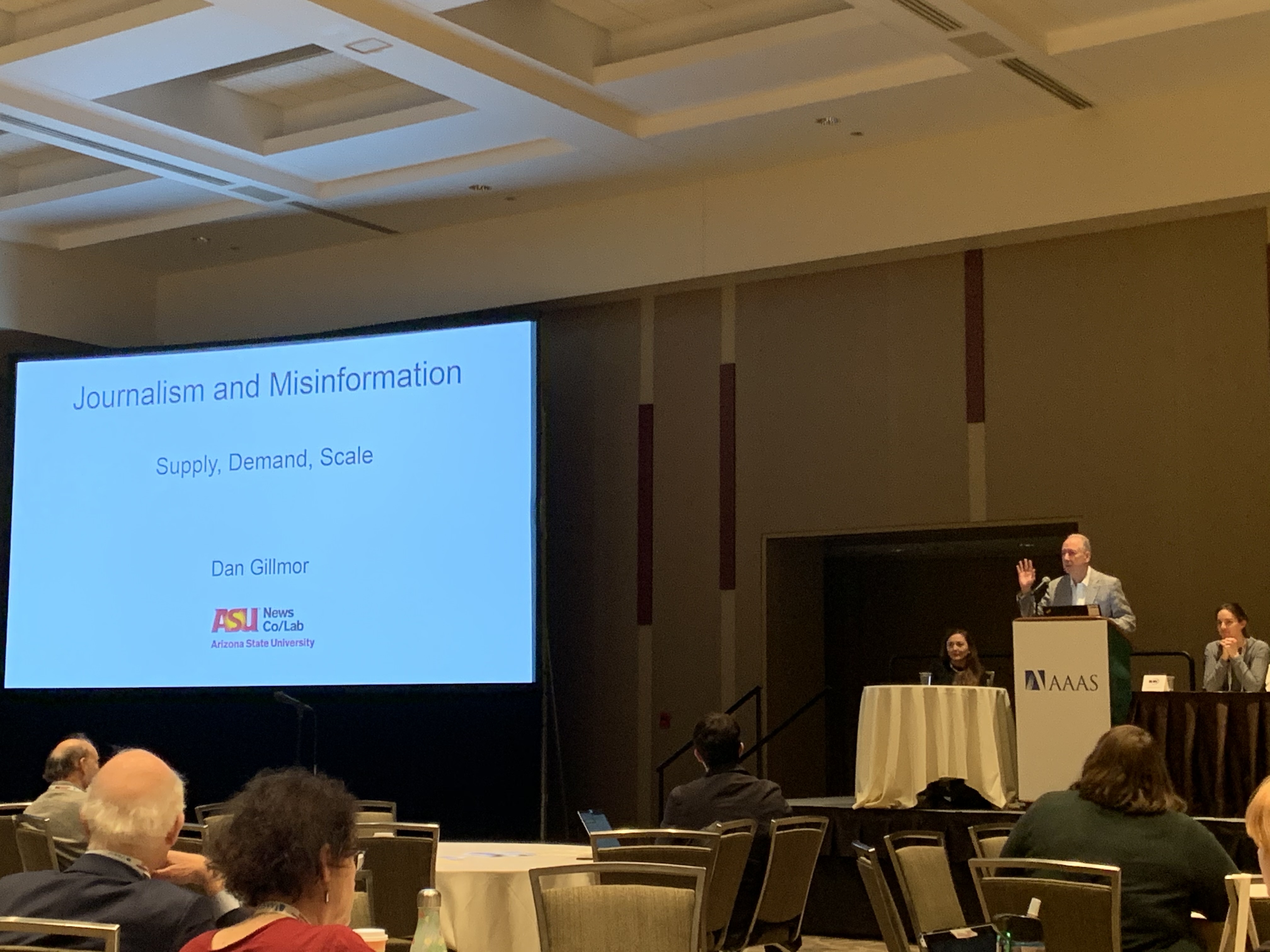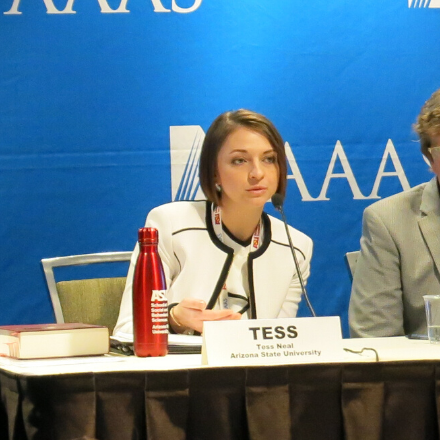At the world’s largest general scientific meeting, Arizona State University researchers, faculty, staff and students gathered with colleagues to tackle some of society’s grand challenges as part of the annual American Association for the Advancement of Science meeting, held Feb. 13-17 in Seattle.
The meeting included keynote talks by leaders such as Bill Gates, whose foundation has contributed more than $50 billion (including many grants to ASU research) to make a big difference in the fight against the world’s leading cause of death, infectious diseases.
Bill Gates addresses the crowd at the AAAS annual meeting.
In 1990, more than 12 million children under the age of 5 died worldwide. By 2015, the number was 5.9 million, according to the World Economic Forum.
“We should be able to cut child mortality in half again," said Gates. “The goal is to achieve health equity worldwide. To get to health equity, science is where we start.”
This year’s theme was “Envisioning Tomorrow’s Earth,” focused on drawing on our current understanding of the world, presenting many forward-thinking scientific visions and outlining the scientific community’s needs to respond to help solve many pressing problems, including climate change, gene editing, fake news and misinformation, science communications and science literacy, education and outreach.
“Despite all the things we worry about — climate change, hypersonic missiles — we shouldn’t lose sight of the fact that progress has been absolutely phenomenal,” said Gates.
Here are just some of the ASU highlights from the meeting.
Bill Gates outlines the progress made to curb child mortality at the AAAS meeting.
Deepfakes
As the country moves into the 2020 election season, the stakes will become higher on local and national news levels. But with a never-satiated, 24/7 news cycle and daily social media scandals and trending topics, who can we trust for our news?
"We need to get better ourselves at sorting out what we can trust, and understanding our roles as part of a digital ecosystem in which we're sharers and creators as well as consumers," said Dan Gillmor, co-founder of the News Co/Lab at ASU's Walter Cronkite School of Journalism and Mass Communication.
A report released by the News Co/Lab and the Center for Media Engagement at the University of Texas at Austin revealed that nearly a third of media consumers with a college education could not identify a fake news headline. And, consumers with negative attitudes about the news media were less likely to be able to spot fake news or distinguish opinion from analysis or advertising.
“I’m pretty good about this and even I get faked out,” said Gillmor. “Journalism is being humbled by financial problems. I’m convinced there is more misinformation coming to our heads via traditional media than social media."
Dan Gillmor outlined the staggering amount of misinformation in our digital ecosystem and how reporters and citizens can sort through fake news during his AAAS talk.0
The News Co/Lab, which has received support from the Facebook Journalism Project, Craig Newmark Philanthropies, Democracy Fund, Rita Allen Foundation and News Integrity Initiative, collaborates with a number of partners to find new ways to increase public understanding of the news. Research suggests expertise in the area is sorely needed.
Gillmor's presentation pivoted on the need for a better understanding of news and the media, how journalists can prepare for and respond to misinformation, and how consumers can learn to parse what they read and watch so that they don't unknowingly traffic information that was intentionally designed to be misleading.
“The tech industry has to play a bigger role. Something I would like the tech companies to do is give us the tools ... to allow us to become our own editors of the internet. If we don’t collaborate, we are not going to make this work,” said Gillmor.
Nadya T. Bliss, the executive director of the Global Security Initiative at Arizona State University, proposed and organized the panel on disinformation, and served as the session moderator.
The digital afterlife
In addition to trust and truth in the news, today’s digital culture has the potential to catalog every aspect of our daily lives. But what about the digital afterlife? Social media pages and accounts often turn into memorials when someone dies, giving people a chance to still feel connected to those they've lost.
But after we're gone, who owns the information on our pages? Who can access them?
Faheem Hussain, a clinical assistant professor in the School for the Future of Innovation in Society, explored this topic in his riveting discussion during his press briefing and talk at the annual AAAS meeting.
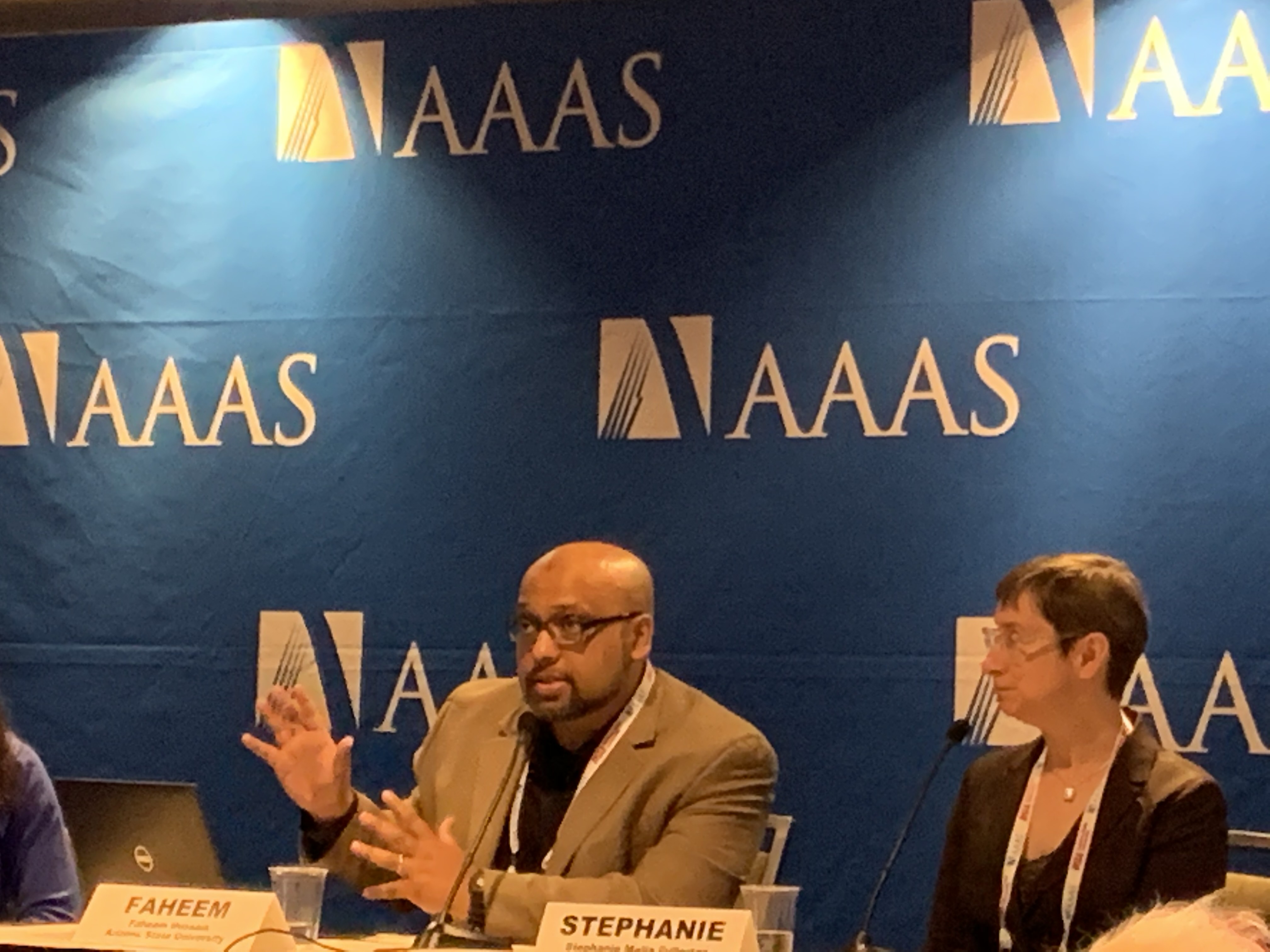
Faheem Hussain is a researcher focused on the digital afterlife.
"It's certain we're going to be dead, so where's the design for that?" said Hussain. "There's a huge design disconnection."
The dilemma of what happens to your digital self after you're gone is something Hussain has seen firsthand. He's witnessed family and friends struggling to gain access to a loved one's social media page after that person passed away, and he's gotten Facebook friend suggestions for a person who had died.
“Any given live account after physical death can open up so many things that may not go with your values, your kin and networks,” said Hussain. “For example, I can have a fake me living happily ever after.”
In his research, Hussain and his colleagues looked at digital afterlife policies, cases and user feedback, specifically in developing countries. They found that people in these countries are more vulnerable to the challenges associated with the digital afterlife, including privacy issues, digital ownership and legal framework. Hussain and his colleagues concluded that more needs to be done to lessen the gap in digital afterlife policies between developed and developing countries, to ensure solutions are inclusive and truly global.
"It's important for us to talk about the digital afterlife," said Hussain. "You need to manage what will happen when you are not here anymore."
And problems surrounding the digital afterlife are not slowing down anytime soon. A recent study found that Facebook could have nearly 5 billion dead users by 2100.
Psychology tests on trial
While we wrestle with our digital selves, an examination of ourselves through psychological tests can profoundly affect people’s lives. For example, almost every legal decision will involve some kind of psychological test.
They can help determine anything from parental fitness for child custody, to the sanity or insanity of a person at the time of a crime, to eligibility for capital punishment.
But new research shows the tests are not all scientifically valid, and once introduced into a case, they are rarely challenged, according to Tess Neal, an assistant professor of psychology at ASU.
Tess Neal is an assistant professor of psychology studying the validity of psychological tests used in the courts.
“Given the stakes involved one would think the validity of such tests would always be sound,” Neal said. “But we found widespread variability in the underlying scientific validity of these tests.”
The problem is made worse because the courts are not separating the good from the bad.
“Even though courts are required to screen out ‘junk science,’ nearly all psychological assessment evidence is admitted into court without even being screened,” said Neal, who presented her findings in the talk “Psychological assessments and the law: Are courts screening out 'junk science?'”
In a two-part investigation, Neal and her colleagues found a varying degree of scientific validity to 364 commonly used psychological assessment tools employed in legal cases. The researchers looked at 22 surveys of experienced forensic mental health practitioners to find which tools are used in court. With the help of 30 graduate students and postdocs, they examined the scientific foundations of the tools, focusing on legal standards and scientific and psychometric theory.
“Most of these tools are empirically tested (90%), but we could only clearly identify two-thirds of them being generally accepted in the field, and only about 40% as having generally favorable reviews of their psychometric and technical properties in authorities like the Mental Measurements Yearbook,” Neal explained.
What is needed is a different approach.
In their open-access paper in Psychological Science in the Public Interest, Neal and her colleagues offer concrete advice for solving these problems to psychological scientists, mental health practitioners, lawyers, judges and members of the public interacting with psychologists in the legal system.
“We suggest that before using a psychological test in a legal setting, psychologists ensure its psychometric and context-relevant validation studies have survived scientific peer review through an academic journal, ideally before publication in a manual,” Neal explained. “For lawyers and judges, the methods of psychologist expert witnesses can and should be scrutinized, and we give specific suggestions for how to do so.”
Citizen science movements
Science has also moved beyond the lab to involve everyday people.
Researchers are using nonscientists more and more to help conduct their research and expand their reach. Everyday people are contributing their data, helping researchers learn more about a topic and get comprehensive results.
But what does "citizen science" mean and how can it support science learning and education?
Darlene Cavalier and Lekelia "Kiki" Jenkins, professors at the School for the Future of Innovation in Society, were members of the first National Academy of Sciences' committee on designing citizen science to support science learning, which authored a report on citizen science.
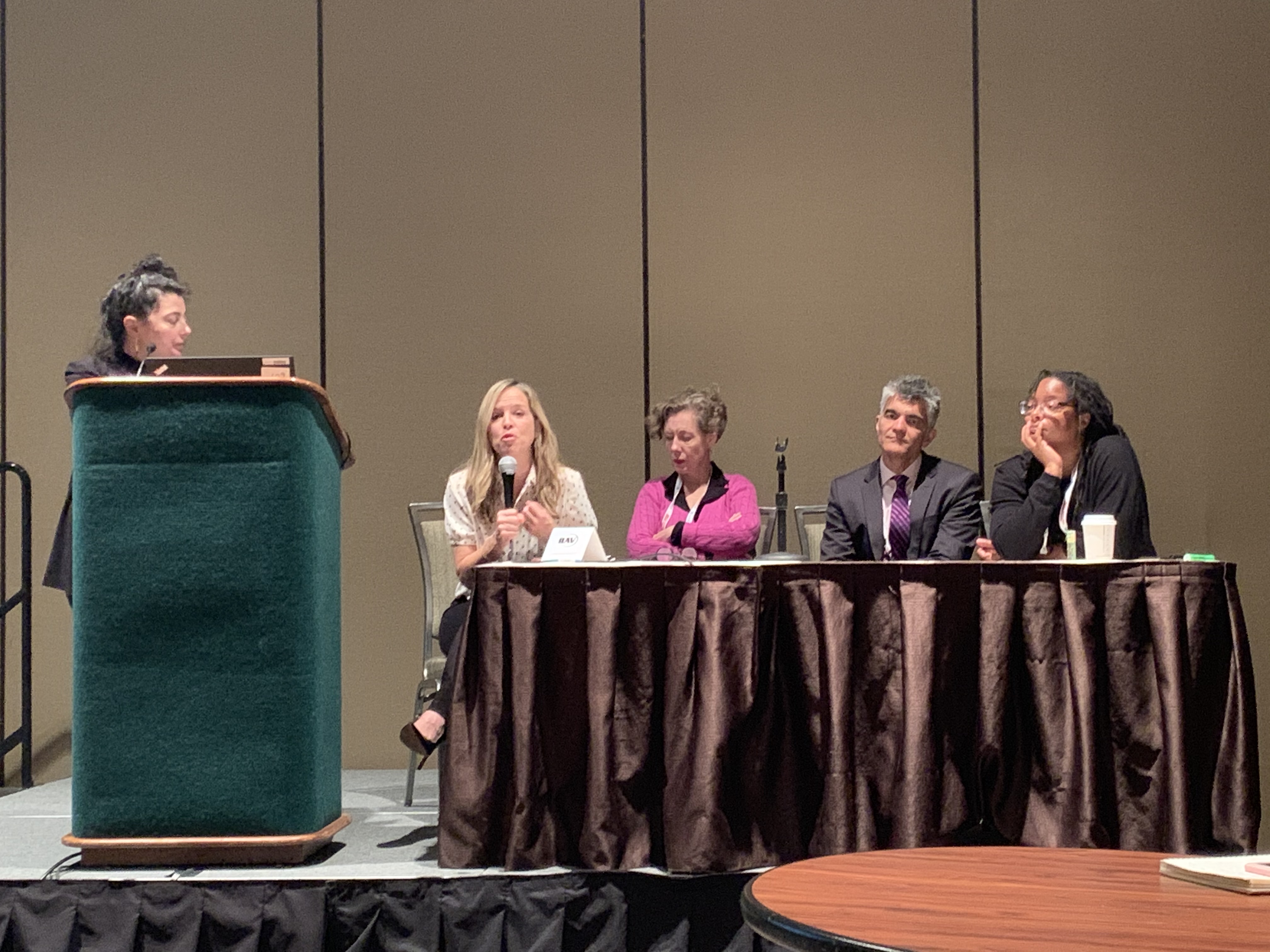
ASU's Darlene Cavalier (holding microphone) and Lekelia "Kiki" Jenkins (far right) are leaders in examining and implementing citizen science.
The National Academies’ report found that citizen science is reshaping research. It can greatly facilitate large-scale research by providing opportunities to study more topics while teaching people more about science and enhancing science education.
The report is one of the first of its kind to examine the available information on citizen science projects and, through peer-reviewed evidence, clearly identify trends, weaknesses and opportunities for growth.
"This session specifically highlights the potential of citizen science to support science learning," said Cavalier. "We'd like to share best practices to intentionally design citizen science programs with science learning as one goal. Personally, I enjoy the Q&A sessions where I learn about developments and hear from people shaping the field."
"We need to understand where we are before we can start thinking about where we need to go," offered Jenkins, who organized the AAAS session in addition to her presentation. "That's the reason why this study was done, because people were doing citizen science and assuming that (because) you're doing science, you're going to learn something. But without being directed in what are the learning objectives and how we are building in support structures to make sure people are learning these things, actually what we find is that people don't learn as much as they could."
Cavalier and Jenkins are putting the lessons learned from the report into practice.
Cavalier, a professor of practice, is a founding board member of the Citizen Science Association. She's also the founder of SciStarter, a platform that connects people to citizen science projects they can participate in. She says she wanted to learn more about how people without formal degrees could participate in science.
Cavalier and a team from the School for the Future of Innovation in Society and ASU Library recently developed citizen science kits that can be checked out of local libraries. The kits include all the instruments and resources needed for people to research things like light pollution, air quality and biodiversity.
Jenkins focuses much of her research on marine conservation, including studying fisheries learning exchanges, where fishing communities learn from each other how to mitigate common problems involving habitat damage and decreasing fish populations. Fisheries learning exchanges and citizen science share similar approaches to collective problem-solving. Jenkins has even developed a “Sea Turtle Science Dance” as a way to communicate science to the public.
When done right, citizen science can be an opportunity to support and extend learning and welcome different skills and beliefs. But according to the report, those opportunities can only be reached if diversity, equity and inclusion are included as goals in a project's original design. Jenkins said people have to intentionally design citizen science projects around those three things; otherwise, it can lead to bias in the project.
"It's a mission that everyone needs to take up if they care about those issues," said Jenkins. "We all have a role to play around diversity, equity and inclusion in the sciences."
Coral reefs: Centuries of human impact
Nowhere is citizen science making a higher impact than advocacy and participation in climate change studies. Among the major regions under threat are our oceans. And we are to blame.
Accounting for one-third of all biodiversity in the oceans are coral reefs. But long-standing human stressors including agricultural runoff and overfishing and more recent ocean warming from climate change have all contributed to large-scale coral reef die-offs.
"Coral reef ecosystems now appear to be unraveling before our eyes, with intensifying outbreaks of coral disease and bleaching threatening the persistence of reef habitats and the immense biodiversity they support," said Katie Cramer, an assistant research professor at the Julie Ann Wrigley Global Institute of Sustainability at Arizona State University and an Ocean Science Fellow at the Center for Oceans at Conservation International.
Cramer's work focuses on reconstructing long-term changes in coral reef ecosystems by combining paleoecological, historical and modern survey data to pinpoint the mechanisms of reef declines and inform conservation efforts.
In her AAAS talk, "Coral Reefs: Centuries of Human Impact," Cramer outlined the evidence of the long-ago human footprints that first set the stage for the recent coral reef die-offs we are witnessing today.
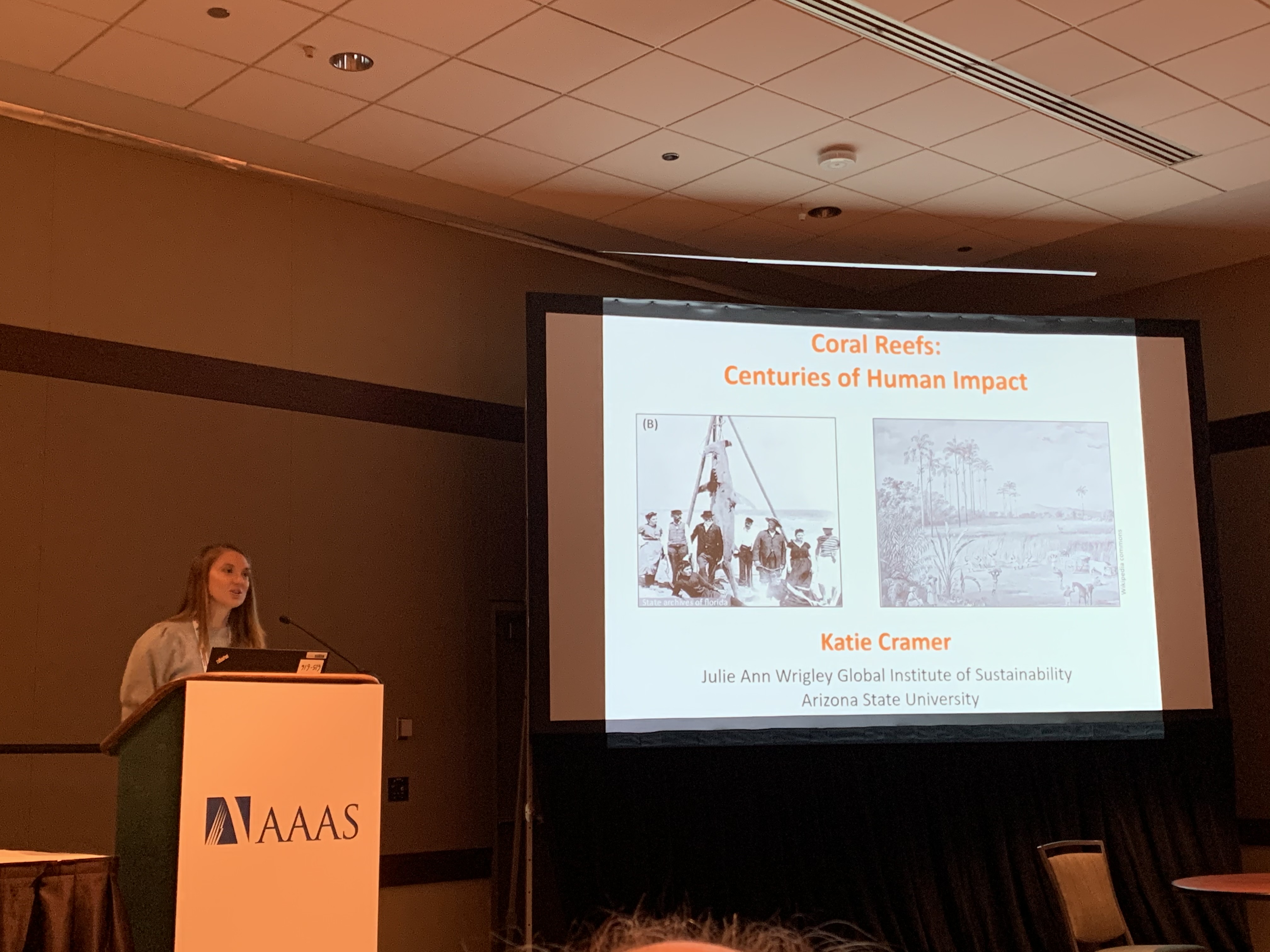
ASU's Katie Cramer outlined the evidence of the long-ago human footprints that first set the stage for the recent coral reef die-offs we are witnessing today.
"I am interested in going back to the scene of the crime when humans first began to impact coral reefs centuries to millennia ago, to understand when, why and how much reefs have been altered by humans," said Cramer.
Her studies have examined the origins of Caribbean coral reef declines by tracking changes over the past 3,000 years in the composition of a variety of fossils found in reef sediment cores she collected from Panama, including coral skeletons, fish teeth, urchin spines, mollusk shells and others.
These studies revealed that long-standing local human impacts such as fishing and agriculture have been profoundly altering reefs at least centuries before the disease and bleaching epidemics that are commonly cited as drivers of coral loss.
In addition, Cramer will also present the first evidence of her study that reconstructed changes in coral communities from reefs across the Caribbean, spanning the prehuman period to the present. This work is revealing that coral communities were being transformed by human activities much earlier than previously thought.
The hope is that by listening to the echoes of past environmental change on coral reefs, Cramer's efforts can better inform conservation efforts in a period of intensifying human-caused threats.
"We need to resolve why and how much coral reefs have changed over human history to inform our responses to the current reef crisis. We need to understand how reefs have responded to past changes to best ensure their persistence into the future," said Cramer.
ASU’s AAAS Fellows honored
Finally, seven outstanding faculty from Arizona State University were honored at the meeting with their induction as fellows of the American Association for the Advancement of Science (AAAS).
ASU’s C. Michael Barton, Julian Chen, Gary Marchant, Emilia Martins, Charles Perrings, Sander van der Leeuw and Hao Yan were honored for recognition of their career contributions to science, innovation or socially distinguished efforts to advance science and its applications.
The new fellows were presented with an official certificate and a gold and blue (representing science and engineering, respectively) rosette pin on Saturday, Feb. 15, at the AAAS Fellows Forum.
The seven new ASU faculty members' election this year brought the total number of AAAS fellows affiliated with ASU to 81.
More Science and technology

Cracking the code of online computer science clubs
Experts believe that involvement in college clubs and organizations increases student retention and helps learners build valuable social relationships. There are tons of such clubs on ASU's campuses…
Consortium for Science, Policy & Outcomes celebrates 25 years
For Arizona State University's Consortium for Science, Policy & Outcomes (CSPO), recognizing the past is just as important as designing the future. The consortium marked 25 years in Washington, D…
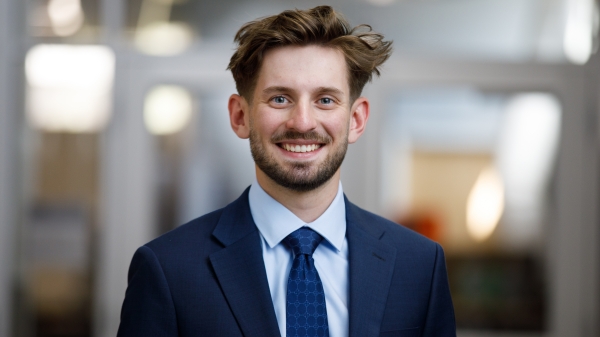
Hacking satellites to fix our oceans and shoot for the stars
By Preesha KumarFrom memory foam mattresses to the camera and GPS navigation on our phones, technology that was developed for space applications enhances our everyday lives on Earth. In fact, Chris…

